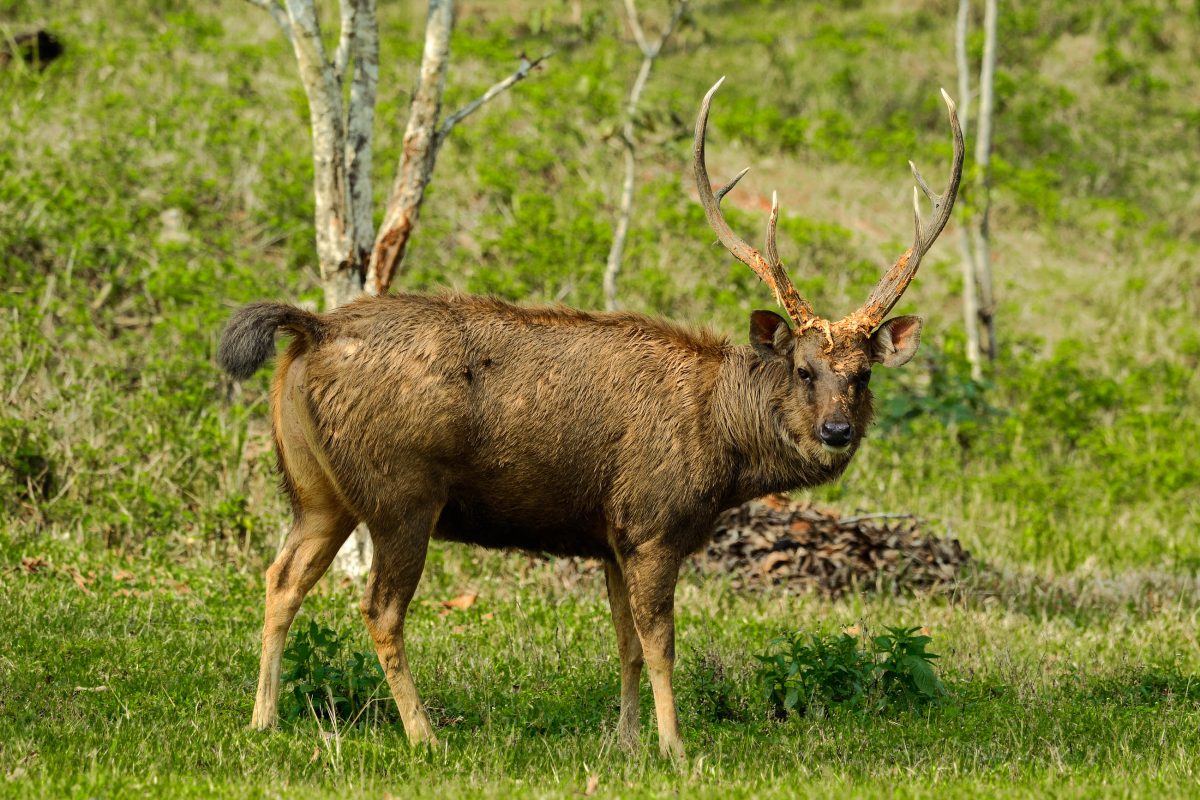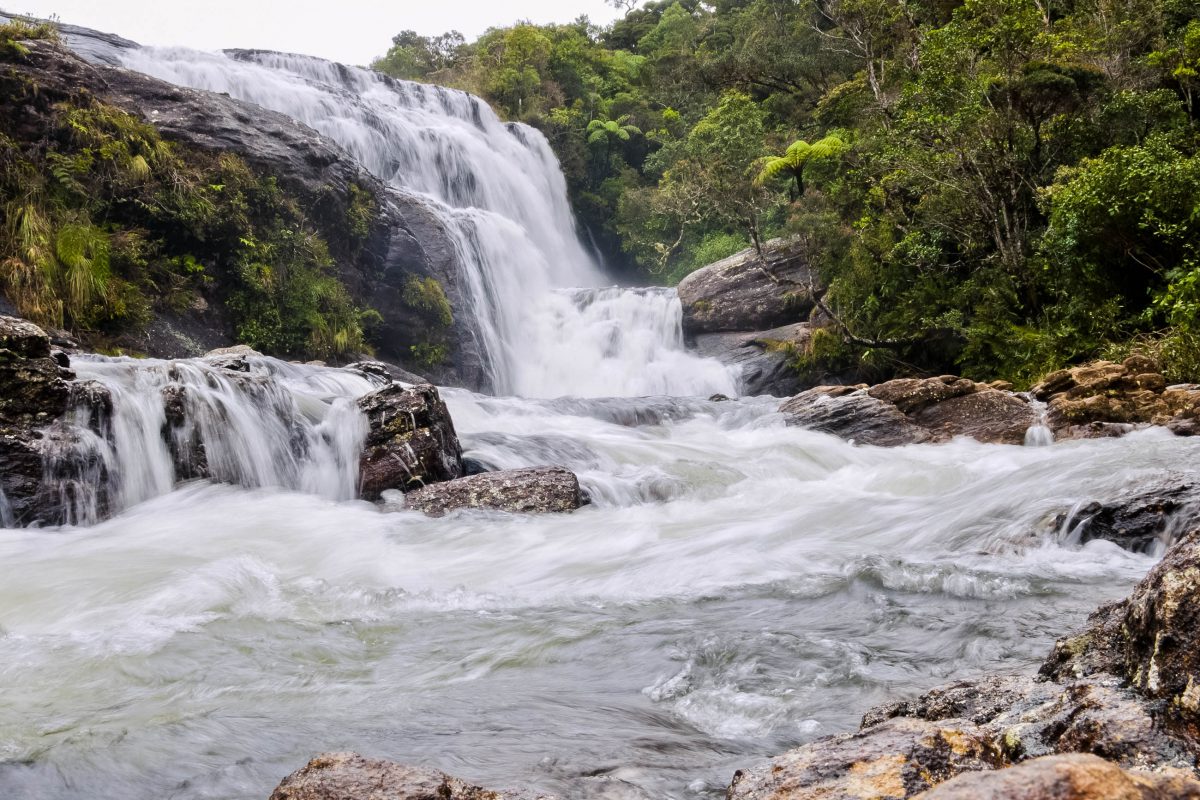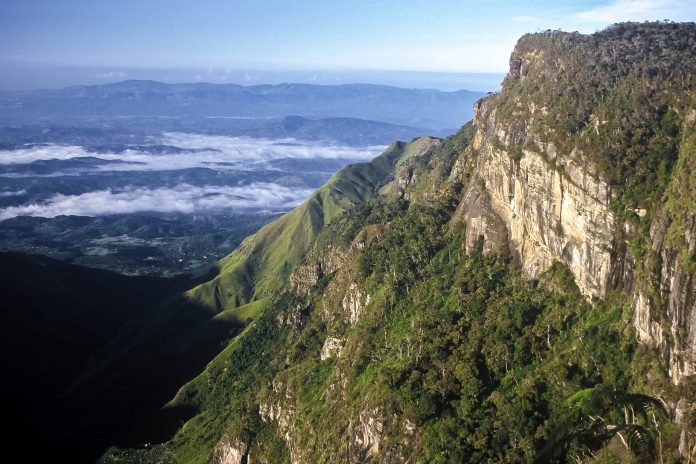Der Horton-Plains-Nationalpark befindet sich im Hochland im Süden Sri Lankas auf über 2.000 Höhenmeter. Seine faszinierende Landschaft und der atemberaubende Aussichtspunkt „World’s End“ sollten am besten am frühen Vormittag besucht werden.
Der Horton-Plains-Nationalpark befindet sich im Hochland im Süden Sri Lankas gut 30 Kilometer von der beliebten Touristendestination Nuwara Eliya entfernt. Benannt ist er nach Sir Robert Wilmot-Horton, dem britischen Gouverneur von Ceylon, wie Sri Lanka damals hieß. Er wurde 1988 zum Schutz der einzigartigen Wälder gegründet und gehört zu unseren Top 10 Sehenswürdigkeiten von Sri Lanka.
Inhaltsverzeichnis
Flora und Fauna im Horton-Plains-Nationalpark

Die gut 30 Quadratkilometer des Horton-Plains-Nationalparks werden vom größten Nebelwald Sri Lankas und feuchtem Grasland bedeckt. Viele der über 700 verschiedenen Pflanzenarten des Nationalparks sind hier weltweit einzigartig, darunter die Hälfte der Baumarten. Charakteristisch sind die verdrehten Äste der Bäume, die sich dem allgegenwärtigen Wind beugen, statt gegen ihn anzukämpfen.
Der üppige Dschungel des Horton-Plains-Nationalparks wird von großen Herden von Samba-Hirschen durchstreift. Sie haben dem Asiatischen Elefanten den Titel des größten Säugetiers im Nationalpark abgeworben, denn die Dickhäuter wurden seit den 1940er Jahren in dieser Region Sri Lankas nicht mehr gesehen. Daneben beherbergt der Nationalpark Makaken, Languren, Wildkatzen, Mungos, Wildschweine und Leoparden. Insgesamt leben im Horton-Plains-Nationalpark 24 Säugetier-, 87 Vogel-, 9 Reptilien- und 15 Amphibienarten.
Klima im Horton-Plains-Nationalpark
Aufgrund seiner hohen Lage auf über 2.000 Metern ist das Klima im Horton-Plains-Nationalpark um einiges kühler und windiger als im Rest von Sri Lanka. Tagsüber sind zwar knapp 30°C möglich, doch nur wenn die Sonne durch die Wolken dringt. Die Durchschnittstemperatur liegt nur mehr bei 16°C, 10°C weniger als an der Küste, in der Nacht kann es, vor allem im Februar, sogar frieren.
Tipp: Aufgrund der großen Höhe auch bei nicht so großer Hitze auf Sonnenschutz nicht vergessen!
Sehenswürdigkeiten im Horton-Plains-Nationalpark
Die fantastische Vegetation des Nationalparks kann auf einer Vielzahl an beschilderten Dschungelpfaden auf eigene Faust erkundet werden. Ein etwa 10 Kilometer langer Weg führt zu allen wichtigen Punkten des Nationalparks und kann in einem halben Tag absolviert werden. Den Besucher erwarten dichter Urwald, rauschende Wasserfälle, weitläufige Grasebenen und sumpfige Marschländer. Am Eingang des Parks befindet sich ein kleines Museum, das wissenswerte Infos über den Nationalpark bietet.
Tipp: Bevor man eintreten darf, werden die Taschen durchsucht – es dürfen keine Plastikbeutel in den Nationalpark mitgenommen werden!
Neben der faszinierenden Gebirgslandschaft des Horton-Plains-Nationalparks gibt es vor allem zwei Attraktionen zu besichtigen.
World’s End
Im Süden des Nationalparks befindet sich das so genannte „World’s End“, „Weltende“, eine atemberaubende Steilwand, über 1.000 Meter nahezu senkrecht in die Tiefe abfällt. An klaren Tagen sieht man von hier aus sogar bis zum Meer.
Tipp: Die größte Chance für die beste Aussicht vom World’s End hat man am frühen Morgen. Bis etwa 9 Uhr ist die spektakuläre Klippe meist noch wolkenfrei.
Nicht weit davon entfernt befindet sich das „kleine Weltende“, an dem die Steilwand „nur“ 270 Meter in die Tiefe fällt.
Bakers Falls

Ebenfalls sehenswert sind die knapp 20m hohen „Bakers Falls“, die nach dem Jäger und Entdecker Samuel Baker benannt wurden, der die Stadt Nuwara Eliya gegründet hat. Der über mehrere Kaskaden fließende Wasserfall wird von einem Wald aus wildem Rhododendron und Farnbüschen gesäumt.
Tipp: Wer den Nationalpark am frühen Vormittag erkundet, kann noch die morgendliche Ruhe und die Einsamkeit der Natur genießen. Für den Besuch empfiehlt sich außerdem ein Wochentag, da am Wochenende auch viele Einheimische die fantastische Aussicht von World’s End aus genießen wollen.
Gefährdung des Horton-Plains-Nationalpark
Die Bedrohungen, mit denen der Horton-Plains-Nationalpark zu kämpfen hat, sind Zerstörung, Feuer und Müll der Touristen (mehrere Samba-Hirsche sind bereits qualvoll verendet, weil sie Plastikmüll gefressen haben) sowie Luftverschmutzung durch den Autoverkehr.
Seit 1978 wurde ein unerklärliches Waldsterben diagnostiziert, welches vor allem die äußeren Regionen des Nationalparks betrifft und an die 50% der gesamten Vegetation dahinrafft. Dem wird mit künstlicher Bewässerung und Düngung entgegengewirkt. Die Aufforstung gestaltet sich durch den gelegentlichen Frost als schwierig.





